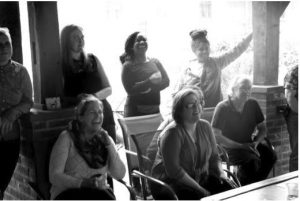
In every area of public concern, organizations from all sectors are coming together to tackle society’s complex, interconnected problems–everything from food insecurity to climate change, from gender-based violence to economic development in rural areas. Recognizing that these issues are complex and interconnected, they’re forming collaborative networks that include non-profits, businesses, governments and communities.
Equity and Inclusion are Non-negotiable
When these diverse stakeholders from multiple sectors come together the need for equity and inclusion across race, gender, age, geography, and beyond, becomes a non-negotiable necessity.
Photo by Quinn Dombrowski from Berkeley, USA – Equity, diversity, inclusion, CC BY-SA 2.0, Link
Giving input is not the same as having power. Providing feed-back is not the same as being a decision-maker. The initiative cannot risk ignoring, overrunning, or out-voting diverse voices. For collaborative networks to succeed in their mission, power must be distributed and equitable.
How decisions get made, who participates in the decisions, and who has power to influence the decisions are key indicators for equity.
In the past multi-stakeholder networks have defaulted to consensus in an attempt to achieve equity. But, consensus often falls short for many reasons and can stall progress. We’ll come back this in a minute.
First, let’s look at the one tension that always shows up in collaborative network initiatives:
Inclusion is fundamental. And. Timely decision-making is crucial.
No one is “in charge” but the success of the mission depends upon widespread participation and buy-in.
So…everyone is assessing both “Is my voice being fairly included?” and “Is this worth my time?”
Inclusion is fundamental
Without the voices from all parts of the system there will be gaps in awareness or understanding that stall or damage the network’s efforts. So networks are bringing people into the conversation who historically are not part of the conversations, communities where decisions have been made that impacted them, but they don’t have a voice.
And, the nature of networks is non-hierarchical. While it’s recognized that inclusion is fundamental to achieving the mission, usually participation is entirely voluntary.
Timely decision-making is crucial
We’ve never seen a collaborative network that wasn’t made up of very busy people with very demanding workloads. And, people care deeply about the issues they’ve shown up to help address.
It can be discouraging and frustrating to try to get everyone to the table at the same time so decisions can be made. Strategies for creating inclusion can often stall decisions that affect staff’s ability to get work done and participants’ ability to experiment with creative solutions.
Beyond a general understanding that good governance will be “consensus-oriented” there’s almost never an agreed upon direction from the beginning about the kind of governance system that works best in that space. They know that they need inclusive processes for making decisions. Yet the group struggles to get to decisions in a way to creates meaningful movement forward.
We developed the Consent Protocol with network partners from the Alaska Alliance that addresses exactly this tension. This protocol allows groups to delegate authority where people are holding responsibility, investing time, or initiating projects AND include all voices impacted by a decision.
Consensus baggage: “it takes too long and things don’t get done!”
When groups try to bring that “consensus-oriented” value into practical reality the work can become very bogged down. People who’ve experienced that inefficiency are often resistant to using consensus. For them, the process took too long and things didn’t get done.
Consensus is a decision-making process. Consent is the foundation for an entire governance system with equitable power distribution. See more about the difference between consensus and consent here.)
The Consent Principle + “Range of Tolerance”provides a framework that allows us to meet the needs for inclusion and buy-in while maintaining autonomy and action.
Collaborative Networks are like Ecosystems
Range of Tolerance is a principle that comes out of ecosystems science. Operating like an ecosystem is a valuable metaphor in collaborative networks.
The nature of the problems collaborative networks are trying to address don’t have simple, clear solutions. The environment changes constantly. Any action in one part of the system will create an effect, often unforeseen, in another part of the system.
Collaborative networks need processes that help people recognize they’re working in a different domain and make space for uncertainty, while still being able to adapt and respond as risks and opportunities arise.
This governance principle, Consent within a Range of Tolerance, provides a structure for people to discover new ways forward. Often, these paths are experimental, iterative, and can be evaluated and adjusted before irretrievable harm occurs in the system.

The Benefits of the Range of Tolerance Framework
The Range of Tolerance framework gives people the language to talk about differences in values and interests without defensiveness.
It allows people to communicate their own boundaries and objections without negating any other members’ boundaries.
It provides a communication framework for people to see other’s perspectives and reveal their own gaps in awareness or understanding.
It does not use the language of “blocking” or “standing aside from” decisions. Instead, it gives people the language to talk about levels of risk (range of tolerance) with different solutions or ideas, and to adapt solutions to mitigate risk.
It supports decisions that are good enough to try and safe enough to fail.
It allows groups to delegate authority with responsibility and experience the advantages of shared leadership.
Consent-based governance provides complex networks with tools, practices and structures to move forward together to address the complexity in our current interconnected problems.
Over nine years we’ve been working with collaborative networks in food systems, economic development, large landscape conservation and more. We’ve had our own consensus baggage, worked with folks across sectors, and sought solutions for wicked problems.

Photo courtesy of Chesapeake Foodshed Network CFN Communications
We’ve found that this powerful decision-making principle, Consent, helps multi-stakeholder networks find the sweet spot for inclusion, equity, and forward momentum.

